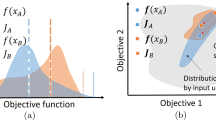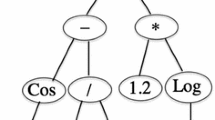Abstract
The design and optimization of engineering products is usually multi-objective, constrained and has uncertainties in the inputs. It is of great importance for taking these uncertainties into consideration during the design process because these uncertainties can significantly degrade the performance of optimal solutions and even change the feasibility of obtained solutions. Most existing Multi-objective robust optimization (MORO) approaches rely on outer-inner nested optimization structures, where a large number of function evaluations is required. In this work, a MORO approach based on Gaussian process (GP) model is proposed to ease the computational burden of MORO under interval uncertainty. To consider the interpolation uncertainty introduced by GP model, an objective switching criterion is developed, which is according to whether the robust status of the individual can be changed because of the interpolation uncertainties from GP model or not. Six numerical and engineering cases with different degrees of difficulty are used to demonstrate the applicability and efficiency of the proposed approach. The objective and feasibility robustness of the obtained optimal solutions are verified via the design of experiment.




















Similar content being viewed by others
References
Arendt PD, Apley DW, Chen W (2013) Objective-oriented sequential sampling for simulation based robust design considering multiple sources of uncertainty. J Mech Des 135(5):051005
Bachoc F (2013) Cross validation and maximum likelihood estimations of hyper-parameters of gaussian processes with model misspecification. Computational Statistics & Data Analysis 66:55–69
Carpinelli G, Caramia P, Varilone P (2015) Multi-linear monte carlo simulation method for probabilistic load flow of distribution systems with wind and photovoltaic generation systems. Renew Energy 76:283–295
Chen S, Jiang Z, Yang S, Chen W (2016) Multimodel fusion based sequential optimization. AIAA J 55(1), 241–254
Cheng S, Li M (2015) Robust optimization using hybrid differential evolution and sequential quadratic programming. Eng Optim 47(1):87–106
Cheng S, Zhou J, Li M (2015) A new hybrid algorithm for multi-objective robust optimization with interval uncertainty. J Mech Des 137(2):021401
Deb K 2014 Multi-objective optimization. Search Methodologies. Springer, pp. 403–449
Deb K, Gupta H (2006) Introducing robustness in multi-objective optimization. Evol Comput 14(4):463–494
Deb K, Pratap A, Agarwal S, Meyarivan T (2002) A fast and elitist multiobjective genetic algorithm: Nsga-ii. IEEE Trans Evol Comput 6(2):182–197
Gabrel V, Murat C, Thiele A (2014) Recent advances in robust optimization: an overview. Eur J Oper Res 235(3):471–483
Gaspar-Cunha A, Covas JA (2008) Robustness in multi-objective optimization using evolutionary algorithms. Comput Optim Appl 39(1):75–96
Gunawan S (2004) Parameter sensitivity measures for single objective, multi-objective, and feasibility robust design optimization. PhD diss., University of Maryland, College Park
Gunawan S, Azarm S (2005) Multi-objective robust optimization using a sensitivity region concept. Struct Multidiscip Optim 29(1):50–60
Hu W (2012) Approximation assisted multiobjective and collaborative robust optimization under interval uncertainty. PhD diss., University of Maryland, College Park
Hu W, Li M, Azarm S, Al Hashimi S, Almansoori A, Al-Qasas N (2009). Improving multi-objective robust optimization under interval uncertainty using worst possible point constraint cutsed. In: ASME 2009 International Design Engineering Technical Conferences and Computers and Information in Engineering Conference. American Society of Mechanical Engineers, pp. 1193–1203
Hu W, Li M, Azarm S, Almansoori A (2011) Multi-objective robust optimization under interval uncertainty using online approximation and constraint cuts. J Mech Des 133(6):061002
Kim N-K, Kim D-H, Kim D-W, Kim H-G, Lowther D, Sykulski JK (2010) Robust optimization utilizing the second-order design sensitivity information. Magnetics, IEEE Transactions on 46(8):3117–3120
Kleijnen JPC (2014) Simulation-optimization via kriging and bootstrapping: a survey. Journal of Simulation 8(4):241–250
Kurpati A, Azarm S, Wu J (2002) Constraint handling improvements for multiobjective genetic algorithms. Struct Multidiscip Optim 23(3):204–213
Lee K-H, Park G-J (2001) Robust optimization considering tolerances of design variables. Comput Struct 79(1):77–86
Li M, Azarm S, Boyars A (2006) A new deterministic approach using sensitivity region measures for multi-objective robust and feasibility robust design optimization. J Mech Des 128(4):874–883
Li M, Hamel J, Azarm S (2010) Optimal uncertainty reduction for multi-disciplinary multi-output systems using sensitivity analysis. Struct Multidiscip Optim 40(1–6):77–96
Li M, Li G, Azarm S (2008) A kriging metamodel assisted multi-objective genetic algorithm for design optimization. J Mech Des 130(3):031401
Li M, Williams N, Azarm S (2009) Interval uncertainty reduction and single-disciplinary sensitivity analysis with multi-objective optimization. J Mech Des 131(3):031007
Mckay MD, Beckman RJ, Conover WJ (1979) Comparison of three methods for selecting values of input variables in the analysis of output from a computer code. Technometrics 21(2):239–245
Mortazavi A, Azarm S, Gabriel S (2013) Adaptive gradient-assisted robust design optimization under interval uncertainty. Eng Optim 45(11):1287–1307
Papadimitriou D, Giannakoglou K (2013) Third-order sensitivity analysis for robust aerodynamic design using continuous adjoint. Int J Numer Methods Fluids 71(5):652–670
Pedersen SN, Christensen ME, Howard TJ (2016) Robust design requirements specification: a quantitative method for requirements development using quality loss functions. J Eng Des 27(8):544–567
Rasmussen CE (2004). Gaussian processes in machine learning. In: Bousquet O, von Luxburg U, Rätsch G (eds) Advanced lectures on machine learning. Springer, Heidelberg, Berlin, pp 63–71
Renaud J (1997) Automatic differentiation in robust optimization. AIAA J 35(6):1072–1079
Schott JR (1995) Fault tolerant design using single and multicriteria genetic algorithm optimization (No. AFIT/CI/CIA-95-039). Air Force Inst of Tech Wright-Patterson AFB OH
Song X, Sun G, Li Q (2016) Sensitivity analysis and reliability based design optimization for high-strength steel tailor welded thin-walled structures under crashworthiness. Thin-Walled Struct 109:132–142
Sun G, Song X, Baek S, Li Q (2013) Robust optimization of foam-filled thin-walled structure based on sequential kriging metamodel. Struct Multidiscip Optim 49(6):897–913
Taguchi G (1978) Performance analysis design. The International Journal of Production Research 16(6):521–530
Van Albada SJ, Robinson PA (2007) Transformation of arbitrary distributions to the normal distribution with application to eeg test-retest reliability. J Neurosci Methods 161 (2): 205–11 Available from: http://www.ncbi.nlm.nih.gov/pubmed/17204332
Wang Y, Chaib-Draa B (2016) Knn-based kalman filter: an efficient and non-stationary method for gaussian process regression. Knowl-Based Syst 114:148–155
Williams CKI, Rasmussen CE (1996) Gaussian processes for regression. In: Touretzky DS, Mozer MC, Hasselmo ME (eds) Adv Neural Inf Proces Syst. Cambridge, MIT Press, 8:514–520
Wu J, Azarm S (2001) Metrics for quality assessment of a multiobjective design optimization solution set. J Mech Des 123(1):18–25
Xiao M, Gao L, Xiong H, Luo Z (2015) An efficient method for reliability analysis under epistemic uncertainty based on evidence theory and support vector regression. J Eng Des 26(10-12): 340–364
Zhang S, Zhu P, Chen W, Arendt P (2012) Concurrent treatment of parametric uncertainty and metamodeling uncertainty in robust design. Struct Multidiscip Optim 47(1):63–76
Zhang Y, Li M, Zhang J, Li G (2016) Robust optimization with parameter and model uncertainties using gaussian processes. J Mech Des 138(11):111405
Zhao L, Choi KK, Lee I (2011) Metamodeling method using dynamic kriging for design optimization. AIAA J 49(9):2034–2046
Zheng K, Yang R-J, Xu H, Hu J (2016) A new distribution metric for comparing pareto optimal solutions. Struct Multidiscip Optim 55(1):53–62
Zhou Q, Shao X, Jiang P, Gao Z, Wang C, Shu L (2016) An active learning metamodeling approach by sequentially exploiting difference information from variable-fidelity models. Adv Eng Inform 30(3):283–297
Zhou Q, Shao XY, Jiang P, Zhou H, Cao LC, Zhang L (2015) A deterministic robust optimisation method under interval uncertainty based on the reverse model. J Eng Des 26(10–12):416–444
Acknowledgements
This research has been supported by the National Natural Science Foundation of China (NSFC) under Grant No. 51505163, No. 51421062 and No. 51323009, National Basic Research Program (973 Program) of China under grant No. 2014CB046703, and the Fundamental Research Funds for the Central Universities, HUST: Grant No. 2016YXMS272.
Author information
Authors and Affiliations
Corresponding author
Electronic supplementary material
ESM 1
(PDF 7 kb)
Rights and permissions
About this article
Cite this article
Zhou, Q., Jiang, P., Huang, X. et al. A multi-objective robust optimization approach based on Gaussian process model. Struct Multidisc Optim 57, 213–233 (2018). https://doi.org/10.1007/s00158-017-1746-9
Received:
Revised:
Accepted:
Published:
Issue Date:
DOI: https://doi.org/10.1007/s00158-017-1746-9




